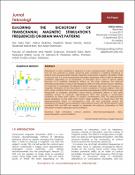Options
Exploring The Dichotomy Of Transcranial Magnetic Stimulation's Frequencies On Brain Wave Patterns
Journal
Jurnal Teknologi
Date Issued
2016
Author(s)
DOI
10.11113/jt.v78.9049
Abstract
Disturbance in brain oscillations is observed in many neuropsychiatric disorders. Any tool that has the potential to restore abnormal brain oscillations is therefore beneficial to patients with neuropsychiatric illnesses. Repetitive transcranial magnetic stimulation (rTMS) is one such tool. It is a non-invasive brain stimulation technique, which is able to alter brain oscillations depending on its parameters of stimulation and is used in clinical setting because of its potential therapeutic effects on the brain. However, the optimum stimulation parameters to induce the therapeutic effect of rTMS remains elusive. Therefore, it is important to investigate the differential effects between high versus low frequency of magnetic stimulation on the mechanism of brain oscillations in human subjects. Here we show, using combined rTMS and surface electroencephalography (EEG) that low and high frequencies of magnetic stimulation would induce dichotomy effects in EEG brain oscillatory activity. In particular, high-frequency rTMS 10Hz induces a synchronised oscillations for theta brain rhythm. In contrast, low-frequency rTMS 1Hz desynchronises neural oscillations on the same brain rhythm. Taken together, our results show that the desynchronisation effect of low-frequency rTMS 1Hz may potentially reverse the interference of altered neural oscillations. More extensive basic and clinical research using combined rTMS and EEG are needed to determine the optimum parameters of rTMS stimulation to restore adequate neural oscillations.
File(s)
Loading...
Name
Exploring The Dichotomy Of Transcranial Magnetic Stimulation's Frequencies On Brain Wave Patterns.pdf
Size
546.86 KB
Format
Adobe PDF
Checksum
(MD5):1f411c64de87e6285e39beb1262ea866